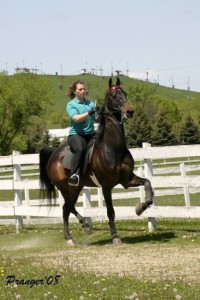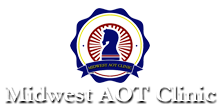As an Amateur Owner Trainer, you will likely lesson less frequently than someone who has a horse in training or is still taking lessons at the academy level. Rather than getting feedback from an instructor 1-3 times a week, you may only be getting that feedback 1-3 times a month or possibly even less frequently. So make that time in front of a professional count!
If you don’t board at a farm with a saddle seat instructor on site you may have to find an instructor who will allow you to haul-in or who will travel. Hauling in requires you to have a trailer, whereas traveling instructors usually charge mileage. Hauling in has the added bonus of allowing you to work your horse someplace other than your home ring.
 Do your homework before your lesson. Work your horse consistently leading up to the lesson and note things you are having issues with. Decide if you are going to ride your lesson in your work bridle or your show bridle.
Do your homework before your lesson. Work your horse consistently leading up to the lesson and note things you are having issues with. Decide if you are going to ride your lesson in your work bridle or your show bridle.
Tell your instructor what you have been working on, your goals and when your next show might be. This will give them an idea of how much to try to tackle in one lesson.
Unless you are having issues in your warm-up, I would recommend getting on your horse and going through your warm up routine before the lesson begins. My usual warm up routine is to walk a horse on a light rein both directions of the ring before I begin picking up the bridle and asking the horse to engage. I think giving the horse this chance to stretch its legs and topline after coming out of its stall is at the very least a politeness I should afford it.
During your lesson, work with an open mind and a listening ear; however, if you do not understand a specific instruction, by all means ask for clarification! But try to stay focused on the ride during the ride; don’t use up riding time talking if you don’t need to. If your instructor asks you to make changes in your equipment (such as the length of your stirrup or the tightness of your curb chain), try it for a while at home after the lesson to see if it makes a difference – don’t just change it right back.
When you’re cooling out your horse at the end of the ride is a good time to ask the big “training theory” related questions that may have come up during the ride. Finish your post-lesson wrap with plans on how you will work your horse until the next lesson or until the show.
Developing a good working relationship with an instructor can be a very beneficial thing for an Amateur Owner Trainer. Having that professional set of eyes on the ground giving you feedback, suggesting changes, acting as a sounding board and knowing you and your horse can be a very productive thing.
We would like to compile a list of trainers/instructors who are willing to assist Amateur Owner Trainers by giving lessons, allowing them to board in their barn, and/or allowing them to stable with them at shows. If you are a trainer/instructor who welcomes Amateur Owner Trainers, please fill out this form to be added to our growing list!
- Trail Riding Your Show Horse - June 7, 2015
- Getting the Most Out of Lessons - May 27, 2015
